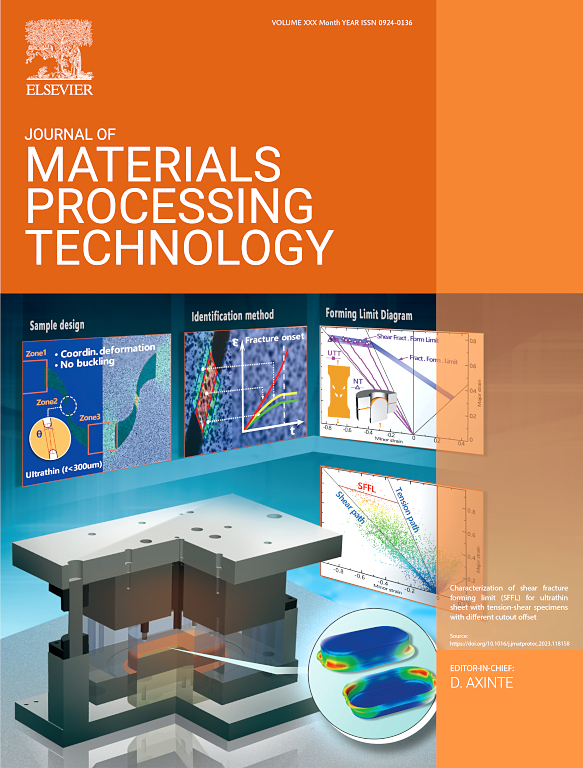具有三维互锁结构的高强度Ti- mg界面的制备、微观结构和力学性能
IF 7.5
2区 材料科学
Q1 ENGINEERING, INDUSTRIAL
Journal of Materials Processing Technology
Pub Date : 2025-07-09
DOI:10.1016/j.jmatprotec.2025.118979
引用次数: 0
摘要
结合钛(Ti)和镁(Mg)合金的复合材料有望具有协同效益——重量轻、强度高、耐腐蚀和生物相容性,但它们的发展受到钛和镁无法形成牢固的冶金结合的阻碍。为了解决这一问题,提出了一种两步方法:首先将Ti网扩散焊接到TC4基体上,然后热压烧结AZ91镁合金到网孔中形成三维(3D)联锁界面。由此产生的3D联锁机械地锁定了两相,将负载从固有的弱Ti-Mg相边界重定向到更强的Ti网格和Mg矩阵。有限元分析和微观结构表征证实了这种从平面应力场到体应力场的转变。在优化条件下,界面抗拉强度为147.8 MPa(占Mg基体的66.8 %),抗剪强度为110.5 MPa(占Mg基体的84.8 %),大大优于传统的平面界面接头。除了Ti-Mg系统之外,该设计范例还可以扩展到具有弱冶金亲和力的不同金属,甚至金属-非金属杂交种,前提是3d骨架相在致密化过程中保持完整,从而为多材料组件中的高性能界面提供了一种通用解决方案。本文章由计算机程序翻译,如有差异,请以英文原文为准。

High-strength Ti-Mg interface with 3D interlocking structure via Ti mesh interlayer: fabrication, microstructure, and mechanical properties
Composite materials combining titanium (Ti) and magnesium (Mg) alloys promise synergistic benefits—lightweight, high strength, corrosion resistance, and biocompatibility, but their development is stymied by the inability of Ti and Mg to form a strong metallurgical bond. To address this issue, a two-step method is proposed: first diffusion-weld the Ti mesh to the TC4 substrate, then hot-press sinter AZ91 Mg alloy into the mesh pores to form a three-dimensional(3D) interlocking interface. The resulting 3D interlock mechanically locks the two phases, redirecting load away from the inherently weak Ti-Mg phase boundary into the stronger Ti mesh and Mg matrix. Finite-element analysis and microstructural characterization confirm this transition from a planar to a volumetric stress field. Under optimized conditions, the interface attains a tensile strength of 147.8 MPa (66.8 % of the Mg matrix) and a shear strength of 110.5 MPa (84.8 % of the Mg matrix), substantially outperforming conventional flat-interface joints. Beyond the Ti-Mg system, this design paradigm can be extended to bond dissimilar metals with weak metallurgical affinity—or even metal-nonmetal hybrids—provided the 3D-skeleton phase remains intact during densification, thereby offering a generalized solution for high-performance interfaces in multi-material assemblies.
求助全文
通过发布文献求助,成功后即可免费获取论文全文。
去求助
来源期刊

Journal of Materials Processing Technology
工程技术-材料科学:综合
CiteScore
12.60
自引率
4.80%
发文量
403
审稿时长
29 days
期刊介绍:
The Journal of Materials Processing Technology covers the processing techniques used in manufacturing components from metals and other materials. The journal aims to publish full research papers of original, significant and rigorous work and so to contribute to increased production efficiency and improved component performance.
Areas of interest to the journal include:
• Casting, forming and machining
• Additive processing and joining technologies
• The evolution of material properties under the specific conditions met in manufacturing processes
• Surface engineering when it relates specifically to a manufacturing process
• Design and behavior of equipment and tools.
 求助内容:
求助内容: 应助结果提醒方式:
应助结果提醒方式:


